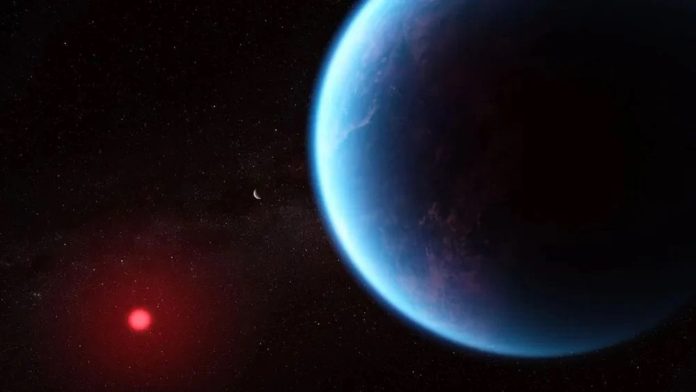
Hycean worlds are also called ocean worlds.
They’re planets covered in oceans that also have thick hydrogen atmospheres. There are no confirmed Hycean worlds—also called ocean worlds—but many candidates.
Even though they’re only candidates so far, researchers are curious about their habitability. New research examines the role tidal heating plays in their potential habitability.
If hycean planets do exist, they’re likely common around red dwarfs (M dwarfs.)
Red dwarfs are the most plentiful type of star in the galaxy, and Hycean worlds’ thick hydrogen atmospheres might protect them from the devastating flaring behaviour of these small, long-lived stars.
Hycean worlds may have larger habitable zones because of all their water, but their hydrogen atmospheres may contribute to the runaway greenhouse effect. When it comes to habitability, these hypothetical worlds are intriguing and mysterious.
In new research to appear in The Astrophysical Journal, the authors argue that for Hycean worlds close to their low-mass stars, tidal heating may be an important factor in determining their habitable zones.
It’s titled “Tides Tighten the Hycean Habitable Zone,” and the lead author is Joseph Livesey. Livesey is from the Department of Astronomy and the Wisconsin Center for Origins Research, both at the University of Wisconsin-Madison.
When a new exoplanet is discovered, one of the first things scientists and the public want to know is if it’s in the star’s habitable zone. Researchers have made significant progress understanding the habitable zones for rocky planets.
“Many studies have parameterized the habitable zone (HZ) for terrestrial exoplanets,” the authors write. “The exact HZ boundaries can vary based on key characteristics such as stellar host type, planetary mass, atmospheric composition, and more.”
But hycean worlds are much different than terrestrial worlds. They’re sub-Neptunes with significant water layers and atmospheres dominated by hydrogen. They’re oddballs, and determining if they are in habitable zones requires a different approach than with rocky planets.
In our Solar System, some of the gas giant moons have frozen shells with liquid oceans underneath. They’re far too distant for the Sun to warm them. It’s tidal flexing that maintains their liquid oceans.
As moons like Europa and Enceladus orbit Jupiter and Saturn, the much-larger gas giants pull on the moons and they flex in response. That action creates heat. So, in effect, tidal flexing creates a habitable zone that’s isolated from the Sun.
Since many hycean worlds are expected to orbit their stars closely, can tidal heating alter their habitable zones?
The researches say that the Hycean Habitable Zone (HHZ), when compared to the terrestrial habitable zone, may include smaller semi-major axes and could even extend to unbound planetary orbits.
A near total absence of GHGs other than hydrogen along with a high albedo allows closer orbital proximity to the star, while internal heating from radiogenic sources, high pressures, a liquid water layer, and larger planet masses extend the HHZ outward.
Tidal heating creates another heat source aside from stellar radiation. Hycean worlds following moderately eccentric orbits experience tidal flexing and heating that shifts the HHZ outward. This creates a smaller HZ than previous estimates based on stellar heating.
Moderately eccentric orbits are common. Our Solar System has massive outer planets that have shifted the orbit of smaller planets into eccentricity. Many other solar systems are likely to have them too, meaning they’re shifting smaller planets into eccentricity.
“These outer companions do occur in planetary systems around M dwarfs; the occurrence rate of giants in such systems has been found to be ∼ 10%, and the occurrence rate of planets in the range 10–100M⊕ is ∼ 20%,” the authors write.
This research shows that tidal flexing on ocean worlds shifts their habitable zones outward. The effect relies on a more massive companion planet that can introduce eccentricity into the hycean world’s orbit.
“Hycean planets are likely to exhibit stronger tidal responses than a fiducial terrestrial world,” the researchers explain. “We expect tides to have little effect on a lone planet at such small orbital radii.
However, the presence of a large outer companion with moderate eccentricity will force an eccentricity cycle that periodically and indefinitely heats the interior of the planet in question, and push out the inner boundaries of the HHZ.”
Though hycean worlds are only hypothetical at this point, their confirmation may not be too distant. Exoplanet scientists are intrigued by them because of their potential for habitability. Their extended atmospheres also make them desirable targets for atmospheric spectroscopy with telescopes like the JWST. K2-18b is a prime example of their potential.
It’s a candidate hycean world that repeatedly generated headlines when astronomers found evidence of water vapor, then carbon dioxide and methane, then the potential biosignature dimethyl sulfide in its atmosphere.
“A recent possible detection of dimethyl sulfide (DMS) in the atmosphere of the potential hycean exoplanet K2-18 b may indicate the presence of ocean-faring life; the only major source of DMS on Earth is phytoplankton,” the authors write.
They point out that on hycean worlds with deep oceans, the ocean tides generate a significant amount of heat that can be used by organisms. This sets them apart from Earth, where the tidal energy is dissipated. “We suggest, therefore, that strong tides on hycean planets could yield a significant power source for life and ultimately accelerate biological evolution,” they explain.
Written by Evan Gough/Universe Today.



